
Tarot is a pack of playing cards, used from at least the mid-15th century in various parts of Europe to play card games such as Tarocchini. From their Italian roots, tarot-playing cards spread to most of Europe, evolving into a family of games that includes German Grosstarok and modern games such as French Tarot and Austrian Königrufen. In the late 18th century French occultists made elaborate, but unsubstantiated, claims about their history and meaning, leading to the emergence of custom decks for use in divination via tarot card reading and cartomancy. Thus, there are two distinct types of tarot packs in circulation: those used for card games and those used for divination. However, some older patterns, such as the Tarot de Marseille, originally intended for playing card games, are occasionally used for cartomancy.
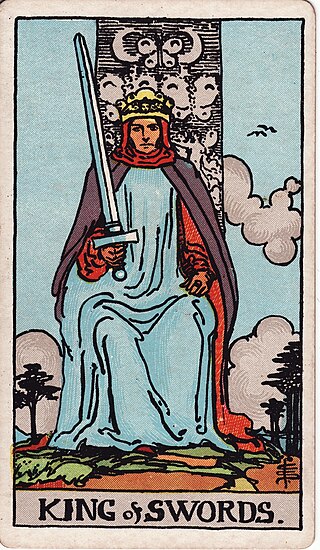
The Minor Arcana, sometimes known as Lesser Arcana, are the suit cards in a cartomantic tarot deck.

The Rider–Waite Tarot is a widely popular deck for tarot card reading. It is also known as the Waite–Smith, Rider–Waite–Smith, or Rider Tarot. Based on the instructions of academic and mystic A. E. Waite and illustrated by Pamela Colman Smith, both members of the Hermetic Order of the Golden Dawn, the cards were originally published by the Rider Company in 1909. The deck has been published in numerous editions and inspired a wide array of variants and imitations. It is estimated that more than 100 million copies of the deck exist in more than 20 countries.

In playing cards, a suit is one of the categories into which the cards of a deck are divided. Most often, each card bears one of several pips (symbols) showing to which suit it belongs; the suit may alternatively or additionally be indicated by the color printed on the card. The rank for each card is determined by the number of pips on it, except on face cards. Ranking indicates which cards within a suit are better, higher or more valuable than others, whereas there is no order between the suits unless defined in the rules of a specific card game. In a single deck, there is exactly one card of any given rank in any given suit. A deck may include special cards that belong to no suit, often called jokers.
A coin is a small, flat, round piece of metal or plastic that is used as money.
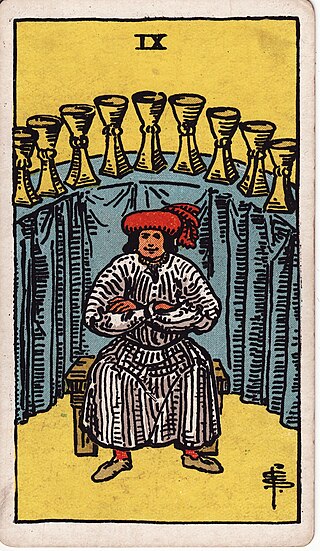
The Nine of Cups is a card used in Latin-suited playing cards which include tarot decks. It is part of what tarot card readers call the "Minor Arcana".
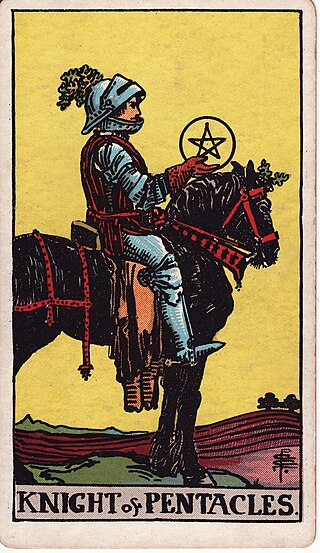
The Knight of Coins is a card used in Latin-suited playing cards which include tarot decks. It is part of what tarot card readers call the "Minor Arcana". The coins" suit is sometimes referred to as "pentacles" or "discs" instead.

Ace of Coins is a card used in Latin-suited playing cards, which include tarot decks. It is part of what tarot card readers call the "Minor Arcana" The coins suit is often called "Pentacles" by tarot readers.
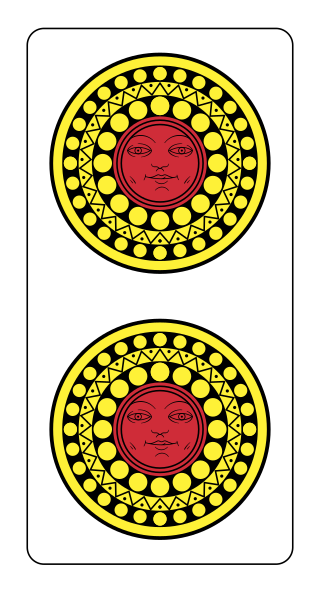
The Two of Coins, or Two of Pentacles, is a card used in Latin-suited playing cards which include tarot decks. It is part of what tarot card readers call the "Minor Arcana."

Four of Coins is a card used in Latin-suited playing cards, which include tarot decks. It is part of what tarot card readers call the "Minor Arcana".
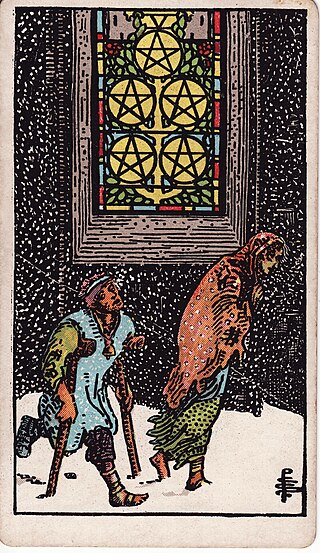
Five of Coins is a card used in Latin-suited playing cards which include tarot decks. It is part of what tarot card readers call the "Minor Arcana".

The Six of Coins, or Six of Pentacles, is a card used in Latin-suited playing cards which include tarot decks. It is part of what tarot card readers call the "Minor Arcana".

The Seven of Coins is a card used in Latin-suited playing cards which include tarot decks. It is part of what tarot card readers call the "Minor Arcana".

Eight of Coins is a card used in Latin-suited playing cards which include tarot decks. It is part of what tarot card readers call the "Minor Arcana"

Nine of Coins is a card used in Latin-suited playing cards which include tarot decks. It is part of what tarot card readers call the "Minor Arcana" and represents a financially independent aristocrat.

Page of Coins is a card used in Latin-suited playing cards which include tarot decks. It is part of what tarot card readers call the "Minor Arcana".
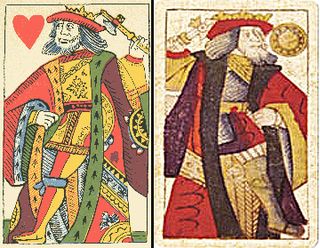
King of Coins is a card used in Latin-suited playing cards. It is the king from the suit of coins. In Tarot, it is part of what tarot card readers call the "Minor Arcana".

The Queen of Coins, also known as the Queen of Pentacles, is a card used in Latin-suited playing cards. It is the queen from the suit of coins. In tarot, it is part of what tarot card readers call the "Minor Arcana".
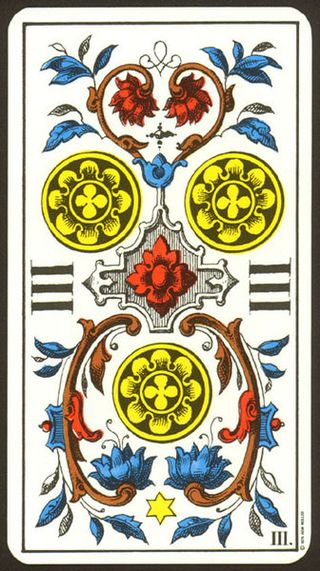
The suit of coins is one of the four suits used in tarot decks with Latin-suited cards. It is derived from the suit of coins in Italian and Spanish card playing packs.

The suit of goblets, more often known in modern times as the Suit of Cups, is one of four suits of tarot which, collectively, make up the Minor Arcana. They are sometimes referred to as chalices. Like the other suits of the Minor Arcana, it contains fourteen cards: ace (one), two through ten, page, knight, queen and king. Historically, the suit represented the First Estate. Tarot cards were originally designed for card play and are still used throughout much of Europe to play various Tarot card games. However, in English-speaking countries, where the games are largely unknown, Tarot cards came to be utilized primarily for divinatory purposes. In modern card games, the equivalent suits are Hearts or Cups.




















